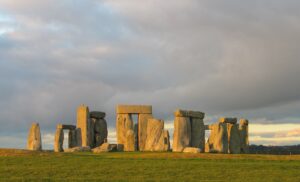
Was anyone else challenged by watching BBC Four romp through the interpretation of Stonehenge through the ages for Timewatch last night? It wasn’t the content – I loved that, there was some great archive footage and it was very interesting to summarize how we have looked at Stonehenge over the last seventy years. What got me was the way in which Stonehenge emerged as a powerful symbol of patriarchy.
I’m not talking prehistory here (well, maybe just a little bit). I’m talking archaeology. Thank goodness the programme was presented by Alice Roberts (I wonder if that was a deliberate decision). Other than that, apart from the work done by Jacqueline McKinley, all of those interviewed or shown in the old footage were men. I did not even try to count them.
This is not the fault of those making the programme. They can only work with the material available. But it is a problem for archaeology. You might think that it is just a sad reflection of our profession in the past, and that things are better now. But I am afraid that is not the case because the Beeb could apparently only find men to comment on the work. Now, I know that all three commentators were people who have been actively engaged with research at Stonehenge in recent years. Indeed, two of them appeared in the earlier footage. But is it true to say that women have nothing to contribute to the Stonehenge debate today?
I wonder if the problem is a little wider than this? Where are the Mary Beards of British Archaeology? We need women with gravitas who can communicate, but what is gravitas? Well, off the cuff, lets assume that in order to have it you need an academic post (two of last night’s commentators were cited as in academia, the other was in popular publishing). I’ve just had a quick look at the staff pages of the four universities in Scotland that have archaeology departments. It is difficult to be certain because each lists staff in different ways, but it looks as if there are a total of 57 academic staff, of whom 23 are women and 34 are men. In order to assess whether or not they have ‘gravitas’ I then tried to investigate the standing of their post. Again it is difficult, but it looks as if there are 18 posts across Scotland at senior lecturer or above, and of these 3 are held by women and 15 by men (interestingly that means that at lower grades 20 are women and 19 are men).
Of course it might just be that women don’t do research on Stone Circles? I’m not going to get into that debate here, though I have a feeling that women are as interested in broadscale Neolithic topics as men are? I had a quick look at Colin Richards’ book Building the Great Stone Circles of the North: he lists 27 co-authors, of whom 18 are men and 9 are women.
I’m not sure where this leaves us. But I’m sad that archaeology can still come over as such a male dominated profession. In fact, thinking of people like Kathleen Kenyon and Isobel Smith, I’m sad that archaeology has ever come over as a male dominated profession. Perhaps men just get to excavate higher status sites? Perhaps we listen more seriously to what men say? Perhaps women measure achievement in different ways? Perhaps women leave academia to move into other posts? Popular communication is a vital part of archaeology in the twenty-first century, though. So it would be good to break that barrier with more than a handful of women.
While I’m moaning – I’ve another gripe about the programme: where was the footage of Foamhenge? Channel Five’s full size polystyrene replica of Stonehenge lingers in my memory for the way in which seeing all the stones upright, as if functioning as a single entity, made me think in different ways about the monument. Of course, last night’s programme was only drawing on BBC archives; my fantasy now is for a programme that uses all the material, whatever the channel, and incorporates a greater diversity of voices in the twenty-first century commentary on past interpretations.
You must be logged in to post a comment.